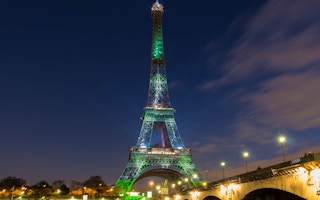Paris plans to turn its school playgrounds into public “oases” offering cool, green spaces for children and parents alike as climate change ratchets up extreme heat and rainfall, just one of 35 actions in a new urban plan for the French capital.
Other programmes will seek to strengthen ties between Paris and the surrounding countryside whose fields feed the city, create groups of residents trained to respond in emergencies and lead community events, and transform the Paris ring road and the motorways leading to it.
The Paris resilience strategy, approved by the city council in late September and launched this week, draws on the capital’s motto “Fluctuat nec mergitur”, Latin for “buffeted (by the waves) but not sunk”.
Sébastien Maire, the city’s chief resilience officer, said the motto - which has been used for centuries - came back into common parlance after the 1910 flood that swamped Paris, and again after militant attacks in November 2015 killed 130 people.
In between, the expression slipped from memories as people placed their faith in technology to solve the world’s ills in the late 20th century, he said.
Now with growing waves of migration and climate change bringing more extreme weather, the need for resilience is firmly back on Parisians’ agenda.
“There are fears about the future - and what the resilience approach proposes is to reassure and protect the population, saying that we are going to face many challenges, but whatever they are, we’re going to adapt ourselves,” he told the Thomson Reuters Foundation. “It is a positive approach.”
The new strategy, drafted with support from the global 100 Resilient Cities (100RC) network, aims to turn risks such as floods and air pollution into opportunities, said Maire.
“
These are the two big challenges facing cities around the world today.
Michael Berkowitz, president, 100RC
For example, Paris has 700 schoolyards covering more than 600,000 square metres of land, made largely of concrete. When heatwaves hit, as they are predicted to do with increasing frequency and ferocity, students can’t go outside as it is too hot and streets swelter amid the “heat island effect”.
The project, due to begin with pilots next year, aims to turn schoolyards into green, refreshing places that can also soak up heavy rain and will be open to local communities at weekends. It shows the “multi-benefits approach of resilience, adaptation to climate change and social cohesion”, said Maire.
Pockets of poverty
Michael Berkowitz, president of 100RC, which is backed by the Rockefeller Foundation, said the new strategy would help Paris tackle inequality and climate change.
“These are the two big challenges facing cities around the world today,” he added.
And Paris’ efforts to knit closer social ties and adapt its infrastructure to climate-linked hazards, like the floods on the River Seine last year, will help other cities learn how to deal with similar challenges, said Berkowitz.
Paris has pockets of poverty and isolation in its suburbs, where many migrants are settling, he noted.
The resilience strategy defines social and economic inequality as one of six major challenges for Paris, seen in rising homelessness, families in sub-standard housing, ill health and nearly a quarter of children living in poverty.
Among the solutions it proposes is an online platform that will help local people and businesses donate goods and services to those in need, boosting neighbourhood solidarity.
“The first lever for the resilience of Paris is its inhabitants,” Maire said.
Their strength in the face of shocks came to the fore after the 2015 attacks, with slogans showing a united front and rejecting fear, he said. “It was a very strong feeling and we built on that within the (resilience) strategy,” he said.
Social cohesion is “something that has been forgotten in big cities, and we want to reinforce it”, he added.
This story was published with permission from Thomson Reuters Foundation, the charitable arm of Thomson Reuters, that covers humanitarian news, climate change, resilience, women’s rights, trafficking and property rights. Visit http://news.trust.org/climate
Our Standards: The Thomson Reuters Trust Principles.










